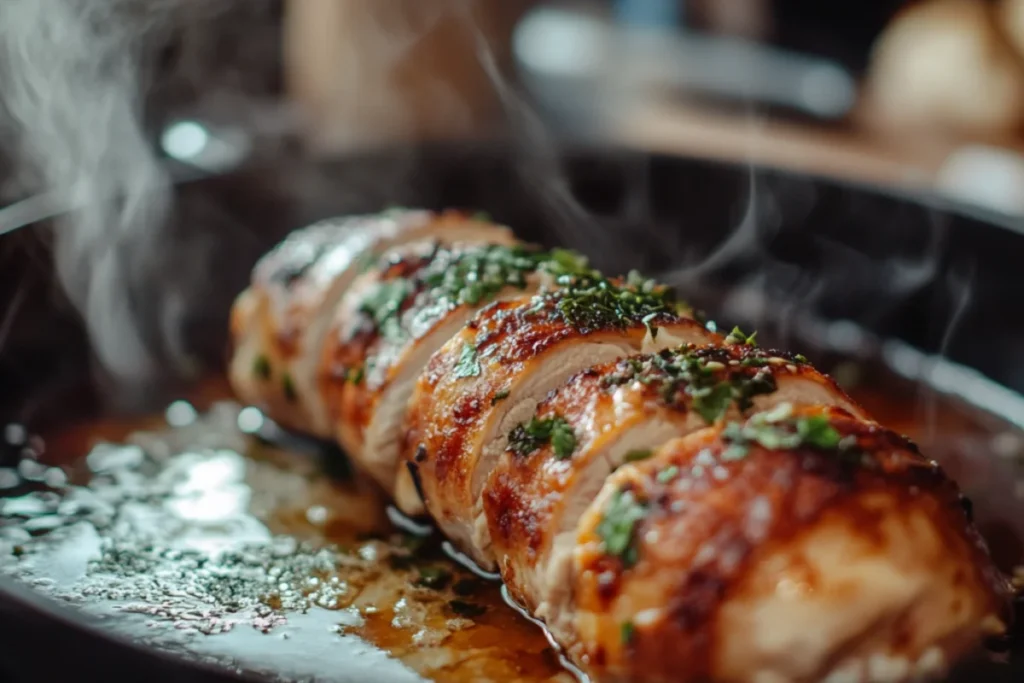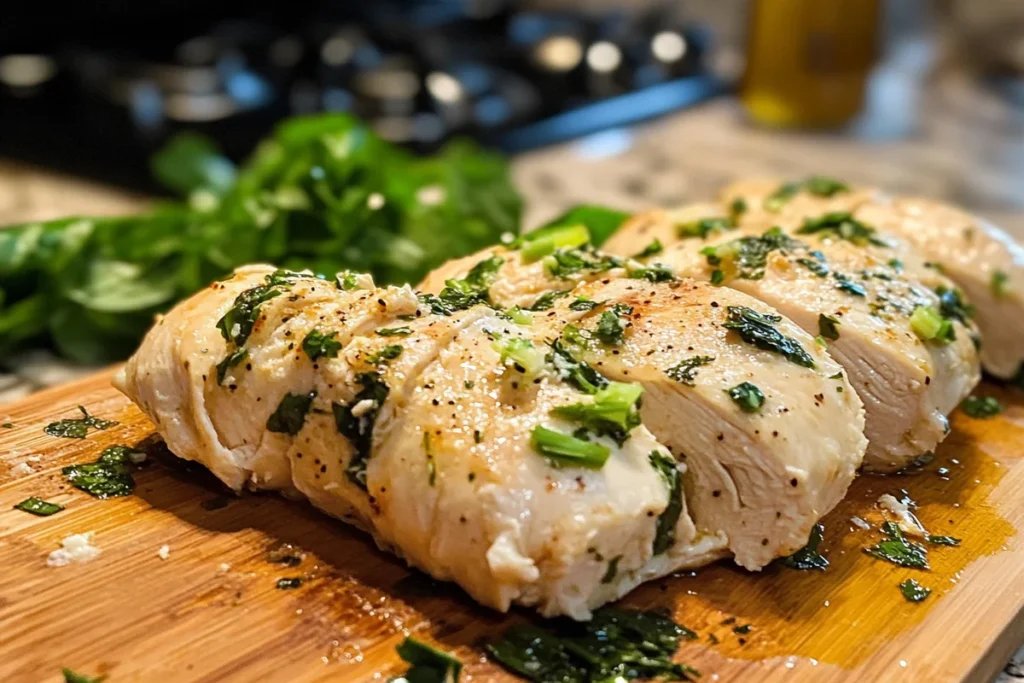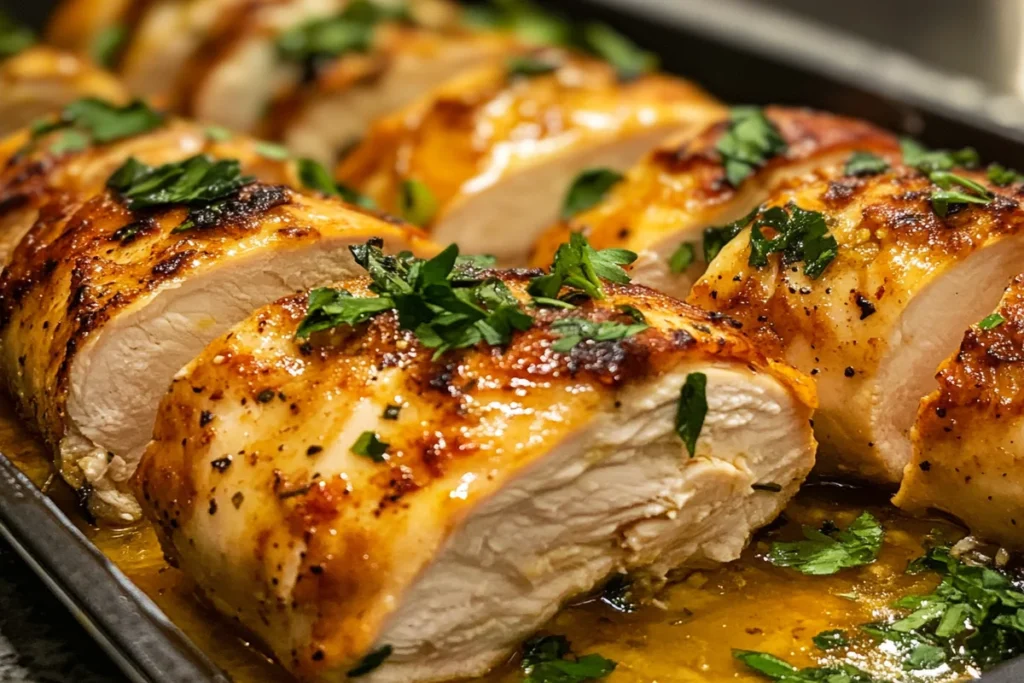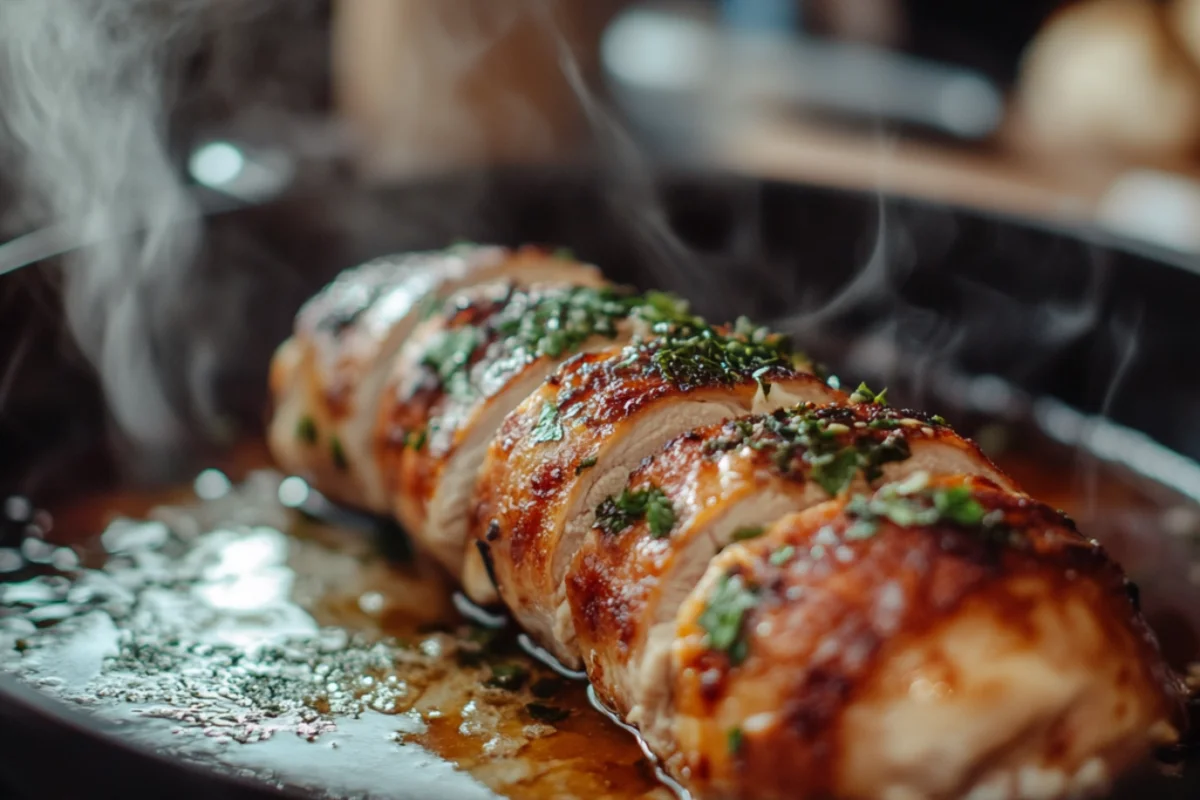
What Is Chicken Roulade Made Of? A Complete Guide to Ingredients and Preparation
Chicken roulade, an elegant dish that’s a feast for both the eyes and the palate, is often associated with gourmet cuisine. Its name may sound fancy, but its preparation revolves around straightforward techniques and accessible ingredients. In this article, we’ll explore everything from what chicken roulade is made of to the various ways it’s prepared, cooked, and served. Whether you’re a home cook or a food enthusiast, this guide will help you master this rolled delight.
Part 1: Understanding Chicken Roulade
Definition of Chicken Roulade
Chicken roulade, derived from the French word “rouler,” meaning “to roll,” is a dish where chicken breast is flattened, filled with a variety of ingredients, and rolled up into a tight cylinder. Once assembled, the roulade is cooked through methods like baking or pan searing. It’s a versatile dish, adaptable to diverse cuisines and preferences, making it a staple in fine dining and casual dinners alike.
Historical Background
The origins of roulade trace back to European culinary traditions. While similar rolled dishes exist worldwide, chicken roulade stands out for its refined approach to combining delicate flavors. Initially popular in French and German kitchens, the dish gradually spread globally, acquiring unique twists based on regional ingredients.
Popularity in Modern Cuisine
Today, chicken roulade is cherished for its versatility. It can be a luxurious main course at celebrations or a lighter meal for everyday dining. From stuffed chicken breasts with Mediterranean herbs to cheese-laden rolls perfect for special occasions, this dish appeals to anyone who enjoys layered textures and rich flavors.
Part 2: Core Components of Chicken Roulade
Main Ingredients
The core of any chicken roulade recipe lies in its carefully selected ingredients. While the specifics vary depending on personal preferences or cultural influences, the essentials remain consistent. Let’s dive into what makes this dish come alive.
Chicken Breast Preparation
The star of the dish is undoubtedly the chicken breast. It’s chosen for its mild flavor and firm texture, which provides the perfect canvas for layering fillings. To ensure even cooking and a smooth roll, the chicken is butterflied and pounded to a uniform thickness. This step not only creates a larger surface for fillings but also allows for easier rolling.
Common Fillings
One of the joys of making chicken roulade is the freedom to choose fillings that suit your taste. Fillings contribute to the dish’s character, ranging from earthy vegetables to gooey cheeses and savory meats.
- Vegetables: Popular options include sautéed spinach, caramelized onions, and mushrooms. These add a balance of nutrition and flavor while introducing vibrant colors to the spiral.
- Cheeses: Cheeses like feta, mozzarella, and cream cheese are common choices. They melt into the roulade, creating a luscious texture and enhancing flavor.
- Meats: Thinly sliced meats such as prosciutto or turkey work wonderfully as fillings, infusing the dish with a smoky, savory depth.
Seasonings and Herbs
No chicken roulade is complete without a dash of aromatic herbs and seasonings. Basil, thyme, rosemary, or parsley elevate the flavor, while a pinch of garlic powder, salt, and pepper enhances the overall taste. A drizzle of olive oil or a touch of lemon zest can also brighten the profile.
Part 3: Preparation Techniques

Preparing the Chicken
The foundation of a successful chicken roulade begins with proper preparation. To create the ideal texture and structure, you’ll need to focus on two key steps: butterflying and pounding.
Butterflying the Chicken Breast
Butterflying involves slicing the chicken breast horizontally without cutting all the way through, creating a “book-like” opening. This step enlarges the surface area, making it easier to hold the fillings while ensuring a uniform shape.
Pounding to Uniform Thickness
Once butterflied, the chicken breast is placed between plastic wrap or parchment paper and gently pounded with a meat mallet. This evens out any thick areas, reducing cooking time and allowing the roulade to cook evenly. A uniform thickness also makes rolling the chicken much easier.
Assembling the Roulade
After preparing the chicken, the fun begins assembling your masterpiece!
Layering the Fillings
Carefully spread the chosen fillings—whether it’s sautéed spinach, gooey mozzarella, or thin slices of prosciutto across the flattened chicken breast. It’s crucial to leave a border around the edges to prevent the fillings from spilling out during rolling.
Rolling the Chicken
Starting from one end, gently but tightly roll the chicken breast into a cylindrical shape, keeping the fillings secured inside. Roll slowly to ensure the spiral remains intact and visually appealing.
Securing with Toothpicks or Twine
Once rolled, secure the roulade using toothpicks or kitchen twine. This prevents the roll from unraveling while cooking and ensures a clean presentation. Remove these after cooking for easy serving.
Part 4: Cooking Methods
Cooking Techniques
Cooking the chicken roulade is where the magic happens. The chosen method not only impacts the flavor and texture but also the visual appeal of the finished dish. Let’s explore the most popular techniques used to cook this culinary delight.
Searing the Roulade
Searing is often the first step in cooking a roulade. By placing the rolled chicken in a hot skillet with a small amount of oil, the exterior develops a golden brown crust. This step locks in juices, adds flavor, and gives the roulade a professional finish. A quick sear on all sides creates the ideal base for further cooking.
Baking to Perfection
After searing, the roulade is transferred to an oven to cook through. Baking at a moderate temperature, typically around 375°F (190°C), ensures the chicken is fully cooked while keeping the meat moist and tender. Covering the roulade with foil during baking can help retain moisture, while uncovering it toward the end achieves a crisp finish.
Alternative Methods
For a twist, try these alternative cooking techniques:
- Poaching: Simmering the roulade in seasoned broth for a delicate, tender result.
- Grilling: Imparts a smoky flavor and crispy char to the roulade, ideal for summer meals.
Tips for Perfect Results
- Always use a meat thermometer to ensure the chicken reaches an internal temperature of 165°F (74°C).
- Let the roulade rest for a few minutes after cooking to allow the juices to redistribute, ensuring each slice is juicy and flavorful.
Part 5: Serving Suggestions

Presentation Ideas
Serving chicken roulade is as much about aesthetics as it is about flavor. Its stunning spiral of fillings deserves a thoughtful presentation to make a lasting impression.
Slicing and Plating
Once the roulade has rested, slice it into even rounds using a sharp knife. The spirals of colorful fillings within the chicken breast create a striking visual. Arrange the slices on a serving plate, slightly overlapping for a layered effect. A drizzle of sauce or a garnish of fresh herbs completes the look.
Accompaniments and Side Dishes
Pairing the roulade with complementary sides elevates the meal. Popular choices include:
- Creamy Mashed Potatoes: The soft texture and buttery flavor balance the roulade’s richness.
- Sautéed Vegetables: Asparagus, green beans, or carrots add color and freshness.
- Rice Pilaf: A lightly seasoned rice dish enhances the roulade without overpowering it.
Sauce Pairings
A well-chosen sauce transforms chicken roulade into an unforgettable dish. Here are some classic pairings to consider:
Creamy Mushroom Sauce
This luxurious sauce, made with earthy mushrooms and heavy cream, perfectly complements the tender chicken and savory fillings.
Tomato-Based Sauces
Light and tangy tomato sauces, often infused with garlic and basil, bring a Mediterranean flair to the dish.
Herb-Infused Oils
A drizzle of olive oil blended with fresh herbs like rosemary or thyme adds a light, fragrant touch.
For a complete experience, consider offering multiple sauce options, allowing guests to choose their favorite.
Part 6: Variations of Chicken Roulade
Regional Variations
Chicken roulade, though rooted in European cuisine, has found its way into kitchens worldwide. Each region adds its unique twist, incorporating local flavors and techniques to create something special.
European Styles
In Europe, chicken roulade often features fillings like spinach, goat cheese, and sun dried tomatoes. Mediterranean-inspired roulades may include olives, artichokes, or herbs like oregano. These variations emphasize fresh, bold flavors and often pair well with light, herbaceous sauces.
Asian-Inspired Roulades
Asian renditions of chicken roulade integrate ingredients like sesame oil, ginger, and soy sauce. Fillings might include shredded carrots, scallions, or even a tangy teriyaki glaze. These versions deliver a sweet-and-savory profile, perfect for adventurous palates.
Dietary Adaptations
One of the great aspects of chicken roulade is how easily it can be tailored to meet dietary needs. From low carb options to vegetarian-friendly alternatives, the dish can be reinvented to suit nearly any preference.
Low-Carb Options
Replace starchy sides with keto-friendly choices like cauliflower rice or zucchini noodles. Inside the roulade, opt for cheeses, spinach, and mushrooms for a filling that’s rich in flavor and low in carbs.
Vegetarian Alternatives
Who says roulade needs chicken? Vegetarian roulades often use eggplant, zucchini, or portobello mushrooms as the base. Fill these with ricotta cheese, fresh basil, and roasted red peppers for a delightful meat free dish.
By exploring these variations, chicken roulade remains exciting and adaptable, ensuring there’s always something new to try.
Part 7: Frequently Asked Questions
What is the origin of chicken roulade?
Chicken roulade originates from European cuisine, particularly French and German traditions. The term “roulade” comes from the French word “rouler,” meaning “to roll.” Over time, the dish evolved to include regional ingredients and has become a versatile favorite worldwide.
Can I prepare chicken roulade in advance?
Absolutely! Chicken roulade can be prepared ahead of time, making it an excellent choice for entertaining. Assemble and secure the roulades, then refrigerate them for up to 24 hours before cooking. Cook just before serving for the best taste and texture.
What are some popular fillings for chicken roulade?
Popular fillings include sautéed spinach, mushrooms, and cheeses like mozzarella or feta. For added depth, thinly sliced meats like prosciutto or turkey are often used. The beauty of roulade is its versatility, so you can experiment with your favorite combinations.
How do I ensure the roulade stays intact during cooking?
To keep the roulade intact, secure it with toothpicks or kitchen twine before cooking. When rolling, ensure it’s tight but not overly compressed. A proper sear also helps seal the edges, locking the fillings inside.
What side dishes complement chicken roulade?
Classic side dishes like creamy mashed potatoes, rice pilaf, or roasted vegetables pair beautifully with chicken roulade. For lighter options, a fresh green salad or steamed asparagus works well.
Is it possible to make a vegetarian version of roulade?
Yes, vegetarian roulades are a delightful alternative. Use thinly sliced vegetables like zucchini or eggplant as the base, then fill them with ricotta cheese, fresh herbs, and roasted vegetables. They’re just as delicious and visually appealing as their chicken counterparts.
This concludes the detailed breakdown of what chicken roulade is made of, from its origins to preparation, cooking methods, variations, and FAQs. Whether you’re preparing it for a casual dinner or a fancy celebration, chicken roulade is guaranteed to impress!
Conclusion: Mastering the Art of Chicken Roulade
Chicken roulade is much more than a simple rolled dish—it’s a canvas for culinary creativity and a testament to the beauty of combining flavors and textures. With its European origins and global adaptations, this dish can be tailored to any occasion or dietary preference. From selecting the perfect fillings to mastering the preparation and cooking techniques, you now have all the tools to create a show-stopping roulade that’s as delicious as it is visually stunning.
Whether you choose a classic spinach and cheese filling, a bold Asian-inspired twist, or a vegetarian alternative, the possibilities are endless. Remember to pair your roulade with complementary sides and sauces to complete the experience. Most importantly, don’t be afraid to experiment and make the dish your own.
So, why wait? Gather your ingredients, sharpen your knife, and start rolling! Your next gourmet adventure begins in your kitchen with this exquisite dish.
Now that you’re equipped with everything from a detailed recipe outline to helpful resources, it’s time to make your version of chicken roulade the star of the table!

